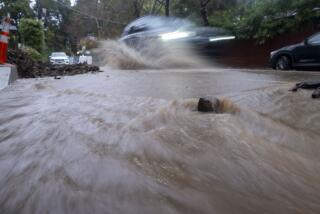A Waterlogged Economy : Outdoor Attractions’ Attendance Tumbles; Building at a Standstill : REGIONAL REPORT
- Share via
Betting is down at Santa Anita Park race track in Arcadia, and construction crews have gone home from Kaufman & Broad’s home-building sites in Vista. Attendance is off at Universal Studios Hollywood, and foot traffic has slowed at Gladstones 4 Fish restaurant in Pacific Palisades.
Everywhere you turn, the record-setting rain that has drenched the region for the last two weeks is hurting Southland businesses. Hundreds of workers have lost hours, if not jobs, and businesses that depend on outdoor work and walk-in traffic are singing the blues.
The problem is not just the quantity of rain, which is the most to fall in Southern California during this time of year in 15 years. It’s the unrelenting showers that for two weeks have given businesses little opportunity to make up for lost time.
And there is no letup in sight for rain-dampened businesses: Forecasts call for continued showers through tomorrow and into next week.
“We’ve had four days this year we’ve actually worked,” said Richard Zimlich, vice president of Champion Roofs of Los Angeles. The nearly nonstop rain has kept Champion from repairing leaky roofs, he added, normally a lucrative source of business.
Among the hardest-hit businesses are outdoor tourist attractions that depend on fabled Southern California sunshine for optimal attendance. The San Diego Zoo, for example, reports attendance down nearly 50% so far this year, a decline that has caused layoffs of several hourly workers.
Other Southland outdoor tourist attractions, including Disneyland and Six Flags Magic Mountain, also have lost turnstile clicks. “Anybody in the outdoor recreation business will tell you that rain is not something that we look forward to,” said John McClintock, spokesman for Disneyland in Anaheim.
“We have been hurt. Rain does cut our attendance,” said Richard Eng, spokesman for Santa Anita Park race track. Combined on- and off-track attendance so far in January is off 5% from the typical daily average of 32,000 fans, he said.
The negative effects of the rains, however, have been minimized by the fact that now is the “slowest time of the year” for many of the state’s tourist destinations, said Phil Keene, president of California Tourism Corp., the Hermosa Beach-based marketing association for the state’s visitor industry. “It isn’t as impact-ful as it might be if it were July,” Keene said.
Notwithstanding high numbers of frustrated beach-goers, even Tan 4 Less tanning salon in San Diego said business is so-so. “People are discouraged to come in because they don’t want to drive in the rain,” manager Michelle Fraser said.
Contractors are also suffering. William Jensen, a project manager with Daley Corp. of San Diego, who is overseeing the grading for new state Highway 56 in north San Diego, said work has been halted on his job site for three weeks.
“We probably won’t be able to work for another week or two because the ground is so saturated,” Jensen said. “As a business, no revenue is coming in, and you still have to pay your salaried people.”
Bernard Sandalow, spokesman for Kaufman & Broad home builders of Los Angeles, said many of the builder’s 60 statewide subdivisions have been affected by the weather, not just those in Southern California. A cement mixer sank in mud up to its axles this week as the company tried to pour foundations for a Modesto subdivision.
Among the few businesses benefiting from the rain are tow-truck operators. Dorothy Mansour, vice president of Rescue Auto in San Diego, says her business is up 50%.
“It’s all the stalled and damaged cars,” she said.
Ira Norris, president of Inco Homes, a home builder based in Upland, said the short-term effects of the rain have been harmful to his business. But the long-term effects may be beneficial if the rain eases the drought, making building permits easier to get from water-conscious municipalities.
“A lot of no-growthers were using the drought to restrict building permits,” Norris said. “They won’t be able to use that again.”
More to Read
Inside the business of entertainment
The Wide Shot brings you news, analysis and insights on everything from streaming wars to production — and what it all means for the future.
You may occasionally receive promotional content from the Los Angeles Times.










